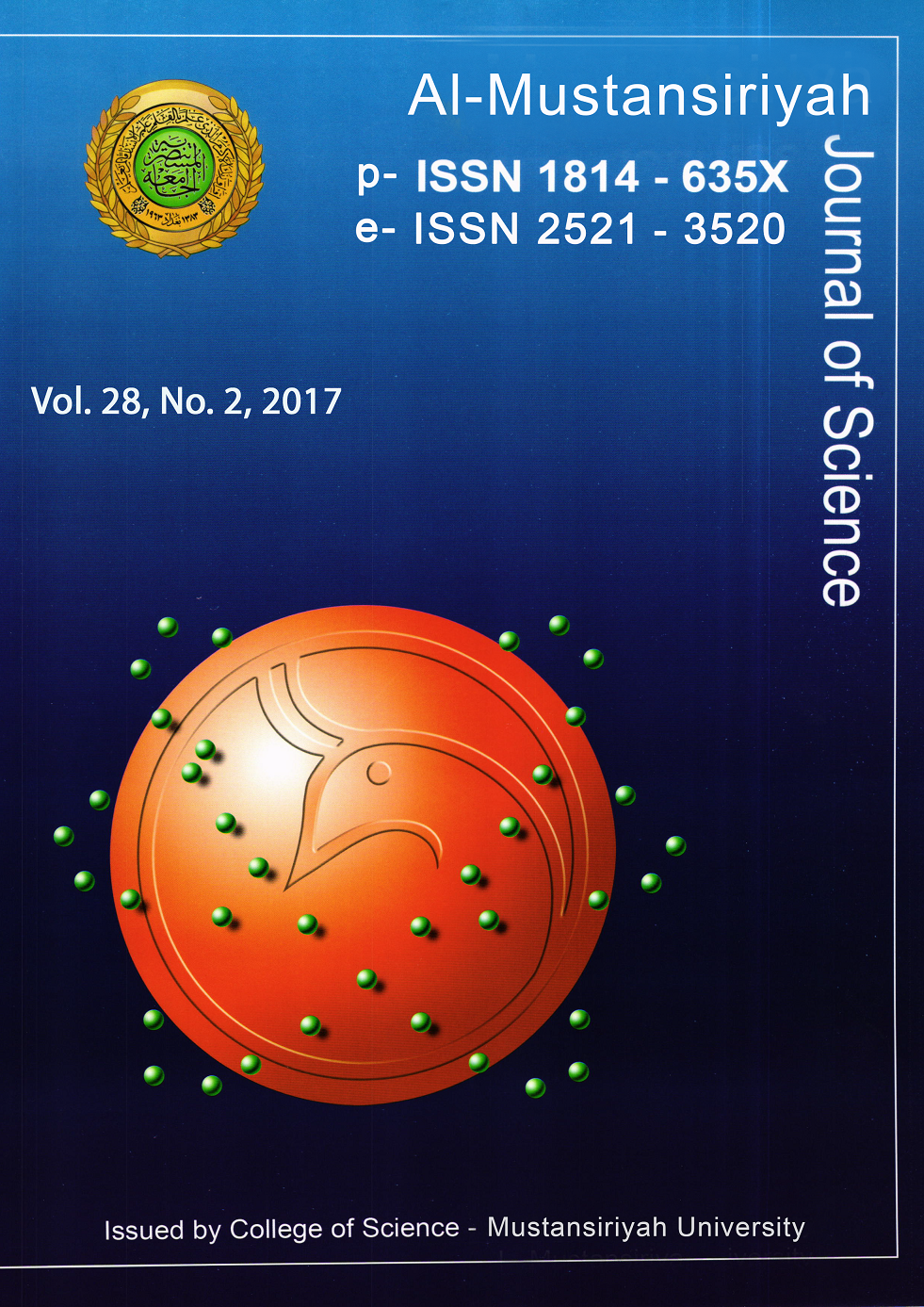Lead Level in Pregnant Women Suffering from Pre- Ec-lampsia in Baghdad City- Iraq
DOI:
https://doi.org/10.23851/mjs.v28i2.493Keywords:
lead, pollution, preeclampsia, symptomsAbstract
This study was conducted on the number of pregnant women suffering from symptoms of preeclampsia who live in different areas in Baghdad city. These areas were suffering from air pol-lution by different pollutants in high rates and it was chosen from among these pollutants lead metal which is a high percentage of air pollution where it was observed by measuring the level of lead in blood serum which taken from pregnant women by 40 pregnant women suffering from symptoms of preeclampsia and 20 pregnant women don't suffering from any abnormal symptoms during pregnancy period and classified as control group , so we found marked a significant rise in lead level in comparison with control group reaching ratio of lead in blood of pregnant women which suffering from symptoms of preeclampsia 38.44 mg/dl ± 3.0 mg/dl in comparison with con-trol group which 14.56 mg/d l± 2.50 mg/dl,this increase may refer to the amount of lead which found in the air and in excess of the normal limit which exposed pregnant women like all people through the overcrowding of roads and use fuel non-environmentally friendly through breathing which effect on pregnant women health, it has been shown on symptoms of preeclampsia from measuring systolic and diastolic blood pressure and measuring of urea in blood, T-test was used at possibility of(0.001)to see the difference between infected samples and control group, therefore this study suggested that a lead is one of the causes of preeclampsia because live in polluted and unhealthy environment. (pt space lineDownloads
References
S. Motawei, S. Attalla, H. Gouda, M. El-Harouny, and A. El-Mansoury, "Lead level in pregnant women suffering from pre-eclampsia in Dakahlia, Egypt," International Journal of Occupational & Environmental Medicine, vol.4, 2013.
M. Bradbury and R. Deane, "Permeability of the blood-brain barrier to lead," Neurotoxicology, vol.14, pp.131-136, 1993.
A. B. Caughey, N. E. Stotland, A. E. Washington, and G. J. Escobar, "Maternal ethnicity, paternal ethnicity, and parental ethnic discordance: predictors of preeclampsia," Obstetrics & Gynecology, vol.106, pp.156-161, 2005.
L. C. Kenny and D. B. Kell, "Immunological tolerance, pregnancy and pre-eclampsia: the roles of semen microbes and the father," bioRxiv, p.198796, 2017.
O. Akinloye, O. Oyewale, and O. O. Oguntibeju, "Evaluation of trace elements in pregnant women with pre-eclampsia,"
56 normal pregnant 38.44 preclamptic lead (mg/dl)
African Journal of Biotechnology, vol.9, pp.5196-5202, 2010.
S. Klitzman, A. Sharma, L. Nicaj, R. Vitkevich, and J. Leighton, "Lead poisoning among pregnant women in New York City: risk factors and screening practices," Journal of Urban Health, vol.79, pp.225-237, 2002.
N. A. Jameil, H. Tabassum, H. A. Mayouf, L. A. Otay, A. A. A. Shenefy, and F. A. Khan, "Identification of predictive marker of prerenal damage in pregnant women with Preeclampsia and women at high risk-A Prospective study conducted in Riyadh, Saudi Arabia," 2014.
N. Al Jameil, "Maternal serum lead levels and risk of preeclampsia in pregnant women: a cohort study in a maternity hospital, Riyadh, Saudi Arabia," International journal of clinical and experimental pathology, vol.7, p.3182, 2014.
P. Pathak and U. Kapil, "Role of trace elements zinc, copper and magnesium during pregnancy and its outcome," The Indian Journal of Pediatrics, vol.71, pp.1003-1005, 2004.
B. Welz, "Atomic absorption spectrophotometry [English translation by Christopher Skegg].2nd comp. rev. ed," ed: Weinheim, Germany, 1985.
S. Kasperczyk, J. Kasperczyk, A. Ostałowska, J. Zalejska-Fiolka, T. Wielkoszyński, E. Świętochowska, et al. , "The role of the antioxidant enzymes in erythrocytes in the development of arterial hypertension among humans exposed to lead," Biological trace element research, vol.130, p.95, 2009.
C. Mosby, W. Glanze, and K. Anderson, "Mosby Medical Encyclopedia, The Signet: Revised Edition," St. Louis, 1996.
J. Neumann, J. Lopuchovsky, and O. Zapletal, "Chemisation, agriculture, pharmacology and toxicology," ed: SZN Praha, 1990.
S. J. Rothenberg, M. Manalo, J. Jiang, R. Cuellar, S. Reyes, M. Sanschez, et al. , "Blood lead level and blood pressure during pregnancy in South Central Los Angeles," Archives of Environmental Health: An International Journal, vol.54, pp.382-389, 1999.
A. K. Mitra, A. Haque, M. Islam, and S. Bashar, "Lead poisoning: an alarming public health problem in Bangladesh," International journal of environmental research and public health, vol.6, pp.84-95, 2009.
A. S. Ettinger and A. M. Wengrovitz, "Guidelines for the identification and management of lead exposure in pregnant and lactating women," 2010.
A. J. McMichael, G. V. Vimpani, E. F. Robertson, P. A. Baghurst, and P. D. Clark, "The Port Pirie cohort study: maternal blood lead and pregnancy outcome," Journal of Epidemiology & Community Health, vol.40, pp.18-25, 1986.
S. Lin, X. Wang, I. T. S. Yu, W. Tang, J. Miao, J. Li, et al. , "Environmental lead pollution and elevated blood lead levels among children in a rural area of China," American journal of public health, vol.101, pp.834-841, 2011.
C. Rusterholz, S. Hahn, and W. Holzgreve, "Role of placentally produced inflammatory and regulatory cytokines in pregnancy and the etiology of preeclampsia," in Seminars in immunopathology, 2007, pp.151-162.
J. Puzas, M. Sickel, and M. Felter, "Osteoblasts and chondrocytes are important target cells for the toxic effects of lead," Neurotoxicology, vol.13, pp.783-788, 1992.
G. Zheng, L. Wang, Z. Guo, L. Sun, L. Wang, C. Wang, et al. , "Association of serum heavy metals and trace element concentrations with reproductive hormone levels and polycystic ovary syndrome in a Chinese population," Biological trace element research, vol.167, pp.1-10, 2015.
Al-Mustansiriyah Journal of Science
Downloads
Key Dates
Published
Issue
Section
License
(Starting May 5, 2024) Authors retain copyright and grant the journal right of first publication with the work simultaneously licensed under a Creative Commons Attribution (CC-BY) 4.0 License that allows others to share the work with an acknowledgement of the work’s authorship and initial publication in this journal.






















